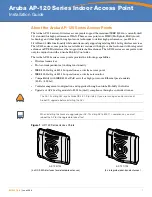
10
Aruba AP-120 Series Indoor Access Point
| Installation Guide
z
Altitude: 8,000 ft @ 28ºC (82.4ºF)
z
Mounting: Wall, ceiling, or desktop mountable
z
Antennas:
3 integrated articulating dual-band antenna elements (AP-121, AP-125)
3 RP-SMA interfaces for external antennas (AP-120, AP-124)
z
Visual Status Indicators (LEDs): See
Table 3
Electrical
Ethernet:
2 x 100/1000 Base-T auto-sensing Ethernet RJ-45 Interfaces
MDI/MDX
IEEE 802.3 (10Base-T), IEEE 802.3u (100Base-T). IEEE 802.3ab (1000Base-T)
Power over Ethernet (IEEE 802.3af compliant), 48V DC/200mA (see
Table 1
for pin
configuration)
z
Power:
5 VDC power interface, supports powering through an AC-to-DC mains electric power adapter
POE support on Ethernet ports:
– 802.3af-compliant POE sourcing devices
– POE+ (56 V @ 350 mA)
Wireless LAN
z
Network Standards: IEEE 802.11b, IEEE 802.11g, IEEE 802.11a, and IEEE 802.11n (draft)
z
Antenna Type:
Integrated 802.11a/b/g/n omni-directional high-gain antenna
Detachable 802.11a/b/g/n omni-directional high-gain antenna
z
Antenna Gain (Integrated Antennas):
2.4 – 2.5 GHz/3.2 dBi (max)
5.180 – 5.825 GHz/5.2 dBi (max)
z
Radio Technology:
Orthogonal Frequency Division Multiplexing (OFDM)
Direct Sequence Spread Spectrum (DSSS)
z
Radio Modulation Type:
802.11b - CCK, BPSK, QPSK
802.11g - CCK, BPSK, QPSK,16-QAM, 64-QAM
802.11a - BPSK, QPSK,16-QAM, 64-QAM
802.11n draft 2.0
z
Media Access Control: CSMA/CA with ACK
N O T E
If a power adapter other than the one provided by Aruba Networks is used in the US or
Canada, it should be cULus (NRTL) Listed, with an output rated 5 VDC, minimum 4A,
marked “LPS” or “Class 2,” and suitable for plugging into a standard power receptacle in the
US and Canada.






























